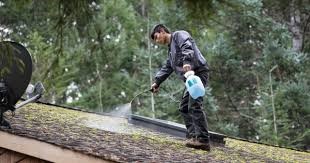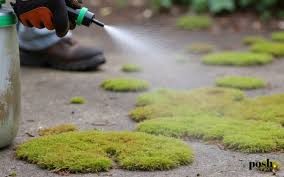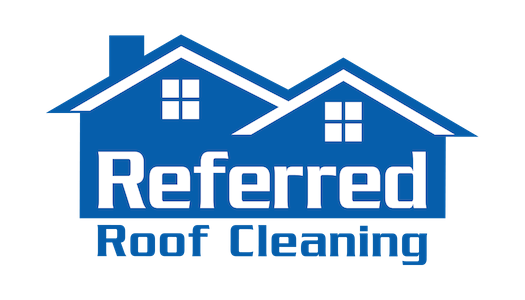Introduction:
Picture staring up at your roof and seeing concerning green blemishes, streaks or fuzzy growth. Often those are moss or algae — our “unwelcome guests.” They may seem harmless, but by allowing them to stick around they can cause expensive damage, discoloration, and decrease curb appeal. Knowing how to remove moss from roof is important to keep your home safe and beautiful.
In this article, we will help you learn how to remove moss from roof, identify the differences between moss vs algae on roofs, and walk you through a step-by-step process — from identifying the problem, to the consideration of chemical vs. natural cleaners — and knowing when to contact a professional.
“Cleaned our roof last spring using the team from Referred Roof Cleaning — no moss, no worries!” — Happy customer
Unmasking the Culprits: How to Remove Moss From Roof by Understanding Their Differences

Looks That Matter: Black Streaks vs. Green Growth
- Algae will appear as dark, wet-looking black streaks or stains, common on shingles facing north.
- Moss will appear as green, cushiony patches, known to be thicker and fuzzier than algae.
- Understanding the differences between the two will help you determine an approach to remove moss from the roof and treat algae stains.
Their Growing Grounds
Moss flourishes in shaded areas or shaded-damp areas, like tree cover. Algae flourish in wet conditions, especially on asphalt shingles, as they consume the limestone filler.
Damage Meter: Which Is Worse?
- Moss is relentless, as it lifts shingles, traps water, and reduces the roof’s lifespan. It can create leaks, rot, and failure.
- Algae usually creates stains and discoloration (i.e. black streaks) on your roof, and while it doesn’t normally damage your shingles, it will have an affect on your curb appeal and property value
How Each Affects Your Roof: Why You Must Remove Moss From Roof Now
2.1. Moss – The Sneaky Saboteur
- Lifts and cracks shingles
- Traps water causing more rot
- Large build-up can reduce the life of your roof by years.
2.2. Algae – The Cosmetic Culprit
- Black streaks that are very difficult to remove
- Does not lift shingles but encourages moisture
- Effects property value mainly at the point of sale.
2.3. When Moss & Algae Team Up
Often, algae grows in and under moss mats that create mixed-growth zones. So, you will have a structural concern (moss) and an aesthetic concern (algae). Both problems raise the demand for focused actions to remove moss from roof and manage roof algae treatment in one effort.
Identification Tips: How to Tell the Difference Between Moss and Algae

To remove moss from roof successfully, proper identification is key.
- Feel it. Moss feels thick and cushiony.
- Look at the color. Moss is bright to dark green; algae is black or gray.
- Observe location. Moss on shady north-facing slopes; algae anywhere moisture lingers.
- Check moisture retention. Moss retains water—algae do not.
Once identified, you can properly plan cleaning and removal.
Removal Techniques: The Battle to Remove Moss From Roof
4.1. Best Methods to Remove Moss and Algae
A) Soft-Washing (Mild, Safe, Effective)
- Mix 50% water with either white vinegar or bleach.
- When using a hose, spray or pour water from bottom to top to avoid damage.
- After spraying, wait 15-20 minutes and softly rinse with a low-pressure hose.
- You’ll want to go back and remove whatever moss is on your roof every 6-12 months!
B) Scrubbing
- Use soft-bristle brush or long-handled broom.
- After spraying, gently scrub downwards to avoid damaging the shingle.
- This option is best for small patches.
C) Chemical Cleaners—When You Mean Business
- Oxygenated bleach (sodium percarbonate): an eco-friendlier option—nothing that will harm plants, or shingles using state-of-the-art technology,
- Use commercial roof cleaning solutions; always follow the instructions/guidelines and wear gloves.
- Caution: do not mix bleach with ammonia or acids—dangerous fumes!
D) Natural Methods: Pet-Friendly, Eco-Safe
- Combine one gallon of water with one cup of baking soda. Spray this on, wait overnight, then rinse.
- Use oxygen bleach (2 oz per 1-gallon) mixed with water, spray it on, then rinse.
E) Professional Roof Cleaning
- Large roofs, steep roofs, or hazardous roofs—call professionals. Amber tiles are especially smart in Salem- they’ve been cleaning roofs in the local climate for a while.
- Most have a safe low-pressure system and only use biodegradable agents approved for roof cleaning.
4.2. Roof Algae Treatment Essentials
- Use any product designated for roofing algae that usually contains either zinc or copper sulfate.
- Use zinc/copper strips at the peak/ ridge of the roof—this will slowly wash down the metal ions preventing regrowth.
- Carefully, spot treat with diluted bleach or hydrogen peroxide and rinse after 15 min.
Chemical vs. Natural Cleaners: Which Is Right?

5.1. Chemical Cleaners (Bleach, Fungicides)
Pros: Gets issues resolved fast, kills deep growth.
Cons: Hard on plants and people. Needs to be handled carefully. Safety gear is required.
5.2. Natural Cleaners (Oxygen Bleach, Baking Soda, and Vinegar)
Pros: Safe for the environment, safe for gardens and pets.
Cons: Longer process may need duplicated effort.
Pro Tip: If only a few spots are affected, go natural. If you’re dealing with major infestations, do a combination approach or hire a professional.
Prevention: Stop Moss & Algae From Coming Back
6.1. Gutter Cleanup & Shade Reduction
- Clean gutters 2 times a year
- Trim branches overhanging the roof to let in some sunlight and improve airflow.
6.2. Install Zinc or Copper Strips
Add close to the roof peak; when it rains, metal ions will wash away and stop growth.
6.3. Use Algae-Resistant Shingles
Shingles that have copper granules added during manufacturing to resist stains and reduce growth.
6.4. Regular Maintenance
Roof inspections 2 times a year. Acting early helps you avoid needing to remove moss from roof in the future.
When to Call Professionals (Moss Removal Services Salem & Algae Roof Cleaning Hillsboro)
Don’t know where to begin? Call in a professional if you:
- Find your roof slope too steep, too tall, or can’t access it.
- Large areas are affected.
- Shingles are damaged by algae or moss.
- You try DIY methods and don’t see any results.
Professionals in moss removal services Salem, and algae roof cleaning Hillsboro will typically provide:
- Roof safe low pressure cleaning
- Use of EPA approved cleaners
- thorough examination and preventative measures for future expansion
Conclusion:
By this point, you’ve learned how to get rid of remove moss from roof, differentiate between moss vs algae on roofs, and decided how to proceed with roof cleaning. You may maintain the efficacy and aesthetic appeal of your roof by promptly identifying the development, cleaning it intelligently, and, most importantly, taking preventative measures. Do not delay—treat it today: the longer you wait, the more small growth will turn into a big problem!
FAQs
-
Does algae harm roofs like moss does?
Algae only leads to cosmetic problems like the black streaking and discoloration of the roof surface, and moss can cause other issues, for example, moss can lift shingles, hold moisture and eventually damage your roof structure altogether, therefore remove moss from roof and treating algae can be apart of roof maintenance.
-
What kills roof moss naturally?
If you’re looking to remove moss from roof using natural products, some natural options include, baking soda (1 cup per gallon of water), white vinegar (50:50 solution with water), or oxygen bleach (2 oz per gallon). Use liberally, soak overnight, and rinse the next day – these options are all safe but very useful for smaller moss patches.
-
How often should I clean my roof?
Cleaning your roof at least twice a year, in the spring and the fall, is the best way to get rid of moss and control algae outbreaks. This will maintain your roof from allowing a moss outbreak and remove algae before it stains your shingles.
-
Can I use chemical cleaners safely on my shingles and/or landscaping?
Yes. Some chemical solutions can safely get rid of remove moss from roof, without harming the shingles or landscaping. Use oxygenated bleach (sodium percarbonate) or roof-safe cleaners, and remember to rinse thoroughly. Covering your plants or giving them a quick rinse with water both before and after using the cleaning solution can help keep them safe.
-
Is it okay to walk on my roof while cleaning it?
No, we don’t recommend that you walk on your roof while you are trying to get rid of remove moss from roof. This action could crack, loosen or damage the shingles. Instead, use a long handled, soft-bristle broom—or, better yet, hire a tradesperson. An industry professional will know how to safely clean the roof.


Recent Comments